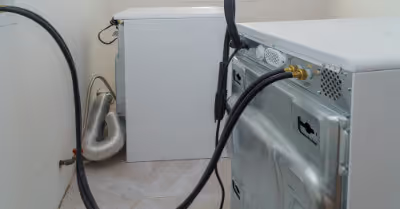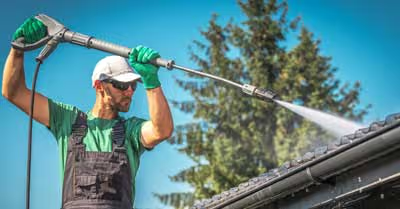Table of Contents
What is Overseeding?
Lawns can get worn down and thin out as the years go by. Many homeowners also have grass that isn’t meant for a particular climate. Overseeding can fill in those bare spots in your yard and thicken the spots that already have grass coverage. This can add curb appeal to your home and give you the lawn you have always dreamed of.
Overseeding is the process of adding grass seed to your existing lawn. This is different from reseeding. Overseeding fill in thinning grass before you have dead spots. Reseeding is resetting the grass growing process to eliminate dead spots.
Overseeding does not require you to turn your soil, but will still create thicker grass and better color. It also gives you a chance to introduce better grass varieties to your yard.
There are additional benefits to overseeding as well. Overseeding can:
- Thicken your lawn
- Help protect your lawn from insects and diseases
- Prevent bare spots
- Enhance color
- Fight stress from droughts
- Improve lawn health
- Protects against weed invasion
Types of Grass to Overseed
Of course the type of grass you choose for overseeding matters, but \the type of grass you currently have matters as well.
Some grass species do not require overseeding. Overseeding is typically used for cool season grasses. This includes:
- Fescue
- Ryegrass
- Bluegrass
However, there are exceptions to this rule. Generally you will not have to overseed if you have a grass type that is spread by “runners.” These types of grass are warm season grasses. One warm season grass that sometimes requires overseeding, though, is bermudagrass.
The type of grass you choose for overseeding should work well with the type of grass you already have. You also need to take your region into consideration. Some grasses grow better in cold climates, while others do well closer to the equator.
Check out this table for some of the types of grasses you can use in your region:
You should always use quality seeds that will sufficiently grow throughout the year. You may want to consider using grass seed that uses Rhizomes to spread because they will grow sideways and fill in bare spots. They also have a thick look when they fill out your lawn.
You also need to use the correct amount of seed for your chosen type. There are recommendations and as a general rule, you should use about half of the amount used for complete seeding. Too little won’t adequately fill out the yard, but too many won’t grow well.
Last, you should make sure that you choose a type of grass that works well with the amount of shade or sunlight you have. Some grasses do not adapt well to minimal sunlight.
The Best Time to Overseed Your Lawn
You should always overseed your lawn according to your climate and type of grass that you are using. Depending on where you live, the best time can be from late Summer or Fall, or it could be in the Spring or early Summer.
It is never good to overseed in times of extreme temperature because it is too harsh for many young grasses. It is also important that the seeds have enough water so that they properly germinate.
If you live in a cooler climate, it is best to overseed in the early fall. You have to give the grass time to germinate before Winter, so if you live in a very cold climate, late Summer is probably best. The warm soil heated by the Summer sun will help the seeds germinate, but the cool air that the Fall brings will help them develop and grow.
If you live in a warmer climate, you should wait until late Spring, or even early Summer if it isn’t too hot, to overseed. For either climate, you can still plant in the Spring or Fall, but be sure to overseed a month and a half before it gets below freezing or before it gets into the 90s in the Summer. The time before extreme temperatures can be even longer depending on the type of grass.
How to Overseed Your Lawn
Overseeding a lawn is not overly complex, but you have to do it right in order for the grass to grow correctly and fill out your lawn. Be sure to choose the right type of grass and time of year, then follow these steps.
What You Need
You don’t need a whole lot to overseed your yard and you likely have most of the tools already. You may need:
- Lawn mower
- Seed spreader
- Rake
- Grass seeds
- Fertilizer
- Aerator (optional)
Prepare Your Yard
This step is essential to quality overseeding. In order for the seeds to germinate, they need to have the correct environment.
The seeds must make contact with the soil. The first step is to mow your lawn short (will likely be shorter than you usually mow it). A good estimate for the length is about an inch or slightly more. If it is longer than 1.5 inches, it could block out essential sunlight and keep the seeds from making adequate contact with the soil. This may be your lawn mower’s lowest setting. Mowing short will also give you more time after overseeding before you mow again. This is important because mowing too soon will rip the young grass out.
The next preparation step is to use a rake or aerator to dethatch the yard. Excessive thatch can cause issues with disease or bugs. It can also prevent your new grass seeds from germinating. During this step you also want to remove all of the grass clippings that are present from mowing.
If you use a rake, pull it in one direction first. Then, after you rake the entire lawn in one direction, pass over it again in the opposite direction. This will pull up the thatch and then you can sweep or grab it off of the lawn.
You can use an aerator to remove thatch. In addition, an aerator can loosen soil and make a better gemination environment for the seeds. This will help it germinate and get the water and nutrients it needs to grow quickly.
Move the aerator along the yard like you would with a lawn mower. Then, go over it a second time making lines perpendicular to the first ones. It shouldn’t punch holes. Instead, it should pull up soil and loosen it.
Overseeding the Lawn
Not your lawn should be fully prepared. Use a spreader to apply the seed evenly on the soil. Make sure you check the label on your grass seed to ensure you use the correct amount.
Do not seed when it is windy because it will blow around. This can waste seed and also make the overseeding uneven. After you seed the entire lawn, you can use the spreader to apply a fertilizer that works well with the type of grass you are using.
Slow-release fertilizer is a good option to provide nutrients to the young grass over a period of a few months. If you use quick-release fertilizer, make sure to apply fertilizer again in about 6 weeks.
As soon as you are finished overseeding and fertilizing, you want to water the lawn. Do not use too much water, but it should be moist.
Maintenance
It is essential to keep the soil moist at all times. You should water your newly overseeded lawn two times a day for the first week. If you overseeded in the late or early Summer and have direct sunlight, this could increase to three times a day. Just make sure to keep the soil moist.
As the grass begins to germinate, you will need to water more. The second week after overseeding requires you to water 2 to 4 times every day. Again, make sure that the soil is consistently moist. You may notice that the water disappears quicker than it did the first week. That means that the seeds and grass are drinking it up!
After two weeks, you can go to regular lawn maintenance. You still need to make sure the grass has enough water, but you won’t need to water multiple times a day. You can also resume normal mowing habits, but if you cut your lawn short enough, and are overseeding in the Fall or Spring, you may not need to mow again for another week or two.
Recent Articles
















